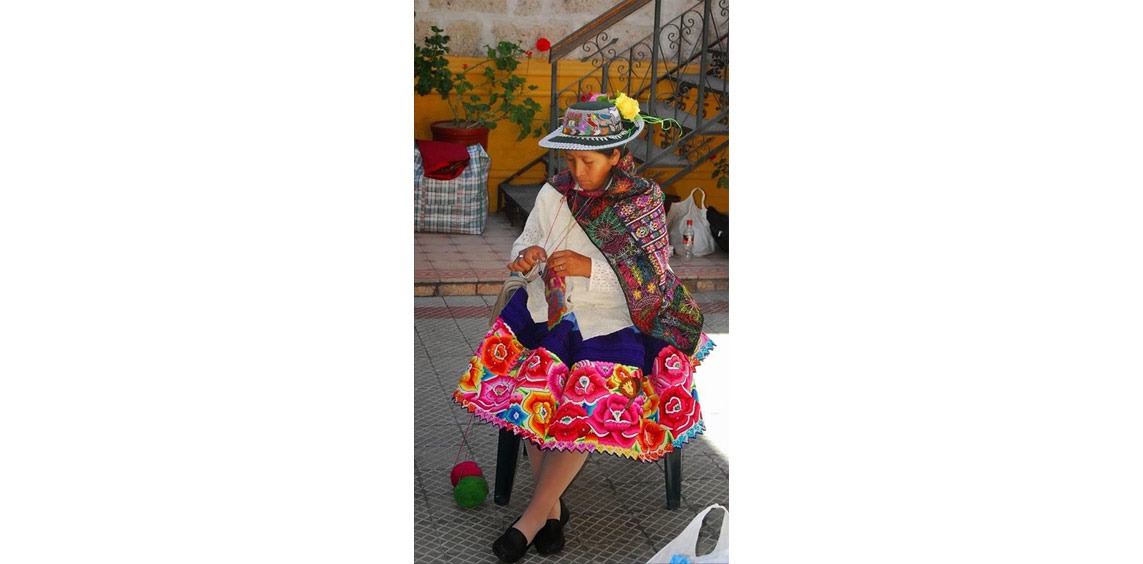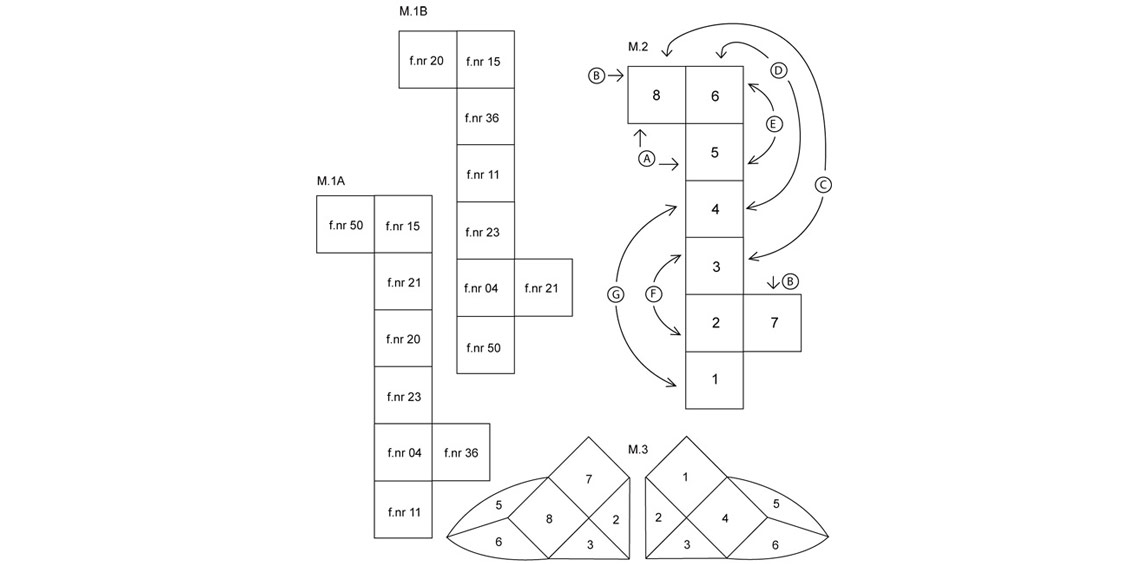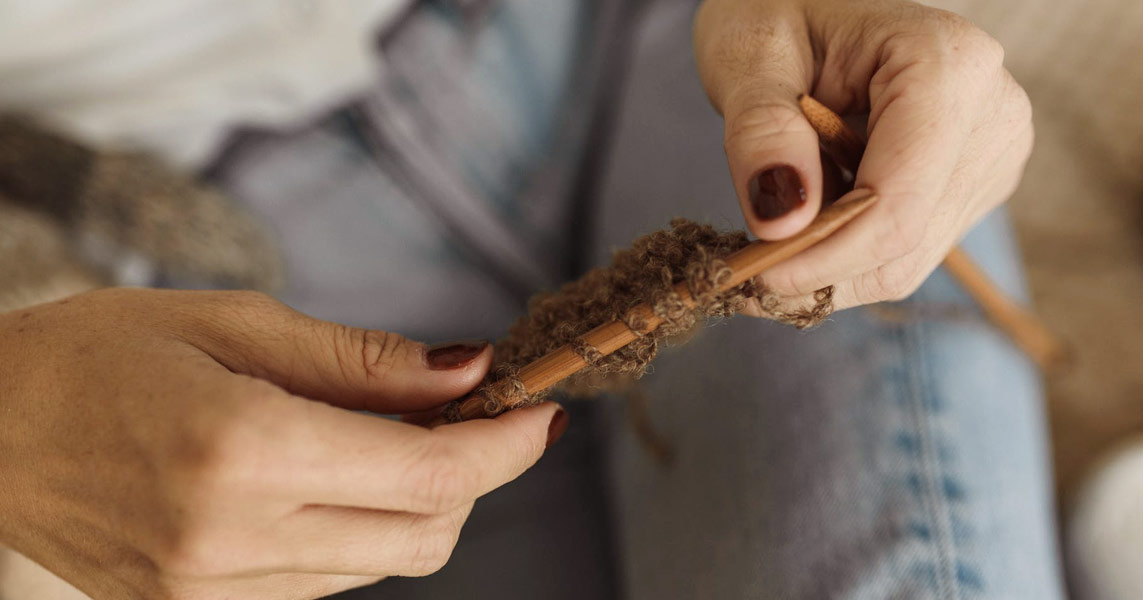Portuguese knitting is one of the oldest forms of knitting. Actually, this unique knitting style was not even born in Portugal, it was brought there through the Portuguese trade with the Persian world, where knitting had been invented already around 700 CE. Later, Portuguese and Spanish colonists brought this new technique to Southern America, whereas Northern European knitters adopted a different knitting style.
Portuguese knitting is said to be an especially good choice for people with joint pains and arthritis because of the little maneuvering of the hands needed to form the stitches. And it is supposed to be a great way for blind or visually impaired people to knit, since the working yarn stays put and you can always find it easily.

What is the set-up for Portuguese knitting?
The holding of the needles is the same as in English or Continental knitting, but you tension the yarn around your neck or via a knitting pin on your left shoulder. Your working yarn comes from the left hand needle.

On your right hand you hold the thread around your middle finger. The important difference is that the knitting action, i.e. the yarning over and pulling the loop through the stitch on the needle takes place in front of your knitting needle and not behind the needle.
You insert the right hand needle under the thread first, inserting the needle to knit just like you would in Continental knitting. But instead of inserting it behind the needle you do it in front of your left-hand needle. Now you just use your left thumb to wrap the yarn around, and then move the right needle in a way that it scoops that stitch towards you. You do not have to move your hands in any way as just flicking your thumb a little. You will find this way of knitting particularly easy on your hands when it comes to purl knits.

The Portuguese style of knitting comes especially handy when you are creating garter stitch garments or when knitting in the round on circular or double pointed needles. Many knitters prefer the Portuguese style particularly for their circular knits. Instead of using knit stitches they just purl their project all the way through because when knitting in the Portuduese style purl knits fly much smoother and with less effort under their fingers. With just a little experience in this technique you may find that you can advance much faster.
Binding off in the Portuguese style is also a little bit different compared to English or Continental knitting. In order to bind off you are going to purl two stitches together. And when you end up with one stitch on the right-hand needle, you just slip that stitch to your left needle and are ready to finish the cast-off.
So why not try this ancient technique which has been passed on for many centuries? See how it feels for your hands, and surprise yourself and your friends with mastering an additional knitting technique.

These beautiful garter stitch Court Jester slippers issued by Drops Yarns are quickly crafted on a pair of single pointed needles. They are entirely made from different sized garter stitch squares which only have to be sewn together.
Here is the free pattern, for which Drops Snow garn and 7 mm double pointed needle were used.
Gauge swatch:
12 sts x 24 rows in garter st = 10 x 10 cm [4’’ x 4’’].
Of course, this pattern is ideal to use up any scrap yarns. However, here is our measurement tip: It is important to adhere to the knitting gauge to make the squares quadratic. The diagonal of 1 square x 2 results in the length of the slipper.
Shoe sizes:
UK: 3/4 - 5/6½ - 7½/9½
EU: 35/37- 38/40 – 42/44
Worked back and forth on needle in squares, the yarn tails are used to sew squares together afterwards.
Cast on 10-11-12 sts on needle size 7 mm [US 10½] Work in garter stitch for 8.5-9-10 cm [3¼”-3½”-4”] (= square 1), change colour and work garter st for 8.5-9-10 cm [3¼”-3½”-4”] (= square 2). Continue like this working different colour squares alternately until you have 6 squares in total. If you are crafting the slipper in just two colours there should be three squares of each colour.
Your piece now measures 51-54-60 cm [20”-21¼”-23 5/8”], bind off. Now pick up 10-11-12 sts on the right side of square 2 with a different colour (= square 7), work 8.5 -9-10 cm [3¼”-3½”-4”] garter stitch, bind off.
Pick up 10-11-12 sts on the left side of square 6 with another colour (= square 8) and work like square 7.

Assembly: Fold slipper and sew together, edge to edge. The sole of the slipper = 24-26-28 cm [9½”-10 ¼”-11”]. Knit another slipper in the same way.
Crochet border: Crochet round the opening of each slipper with crochet hook size 8 mm [L/11] and colour of your choice as follows (beg mid back): * 1 sc, 2 ch *, repeat from *-*, and finish with 1 slip stitch in the first sc from beg of the round.
Do you like this KnitPro blog? Do you want to read other interesting things about Knitting & Crochet? If yes please check our similar blog click here.












